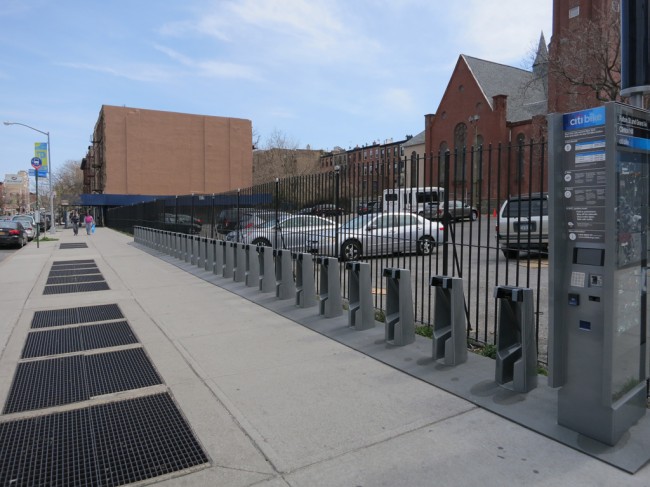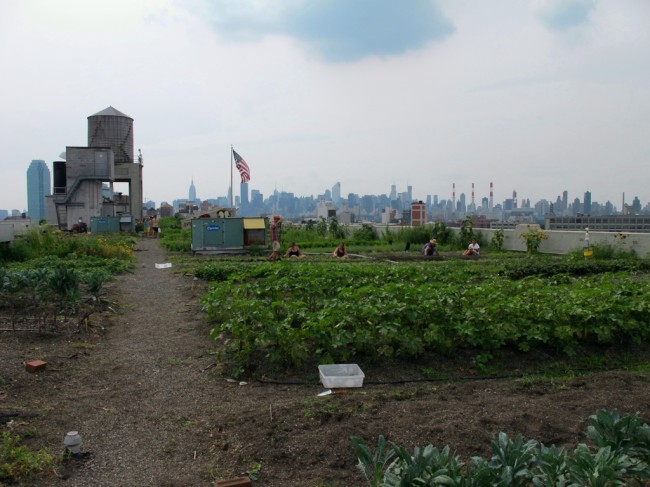
We are celebrating 15 years — and counting — of stories that are deeply researched and deeply felt, that build a historical record of what the city has been.
We are celebrating 15 years — and counting — of stories that are deeply researched and deeply felt, that build a historical record of what the city has been.

Citi Bike comes to Clinton Hill | Image by Doug Gordon via Brooklyn Spoke
BIKE INFRASTRUCTURE BLOOMING
The spring weather has brought with it the long-awaited roll out of NYC’s new bike share, Citi Bike. The first of what will eventually be 600 docks holding 10,000 bikes were installed this week in the Brooklyn neighborhoods of Bed-Stuy, Clinton Hill, and Fort Greene. The first phase of installations will include 300 docks across Brooklyn and Manhattan, and will come online in May. The docks include way-finding maps and “solar poles” that power the system off the grid. Anticipating some inevitable consternation with the siting of the bikes, the Department of Transportation (DOT) also released a detailed report of the extensive public meetings undertaken to decide on their location. The DOT has also released its construction plans for three stretches of the Brooklyn Waterfront Greenway, a 14-mile pedestrian and bike path connecting Greenpoint to Bay Ridge officially announced last June and already in place in parts of Williamsburg, Brooklyn Heights, and Cobble Hill. Construction of the Greenway in Red Hook is slated for the summer; the Greenpoint and Brooklyn Navy Yard sections are planned for 2014.
CHANGE THE COURSE
On Wednesday, the City’s Economic Development Corporation (EDC) unveiled the three winners of Change the Course — The NYC Waterfront Construction Competition, created to “provide innovative and cost-savings soutions for completing marine construction projects and maintaining waterfront infrastructure in New York City.” The winner proposes to 3-D print customized concrete casements to surround and protect the pilings that support buildings along the waterfront. The runners up include a pump that allows oysters to grow on pilings at lower depths, which combats erosion while also cleaning the water, and a proposal to use more durable materials for underwater construction that, although 20% more expensive initially, could double the lifespan of waterfront construction.

A Brooklyn Grange farm in Long Island City | Image via Kristine Paulus
ROOFTOP GREENHOUSES GONE COMMERCIAL
New York rooftops continue getting greener. Gotham Greens is planning three massive new greenhouses across the city. In Gowanus, plans are underway for a 20,000-square-foot greenhouse atop a new Whole Foods Market, which will sell its produce year-round to Whole Foods branches in the city. On the roof of an industrial building in Jamaica, Queens, construction will begin later this year on one of the largest commercial rooftop greenhouses in the nation, which will grow plants hydroponically — using nutrient enriched water instead of soil — and is projected to yield roughly 500 tons of produce and herbs yearly. In the Bronx, the company plans to build a greenhouse on top of the future Oak Point food distribution facility in Hunts Point.
TRANSIT TAKEAWAYS
Transit news came in fits and starts this week. Reviving a suggestion for the extension of 7 train across the Hudson to New Jersey, the Bloomberg administration released a feasibility study Wednesday which was largely met with skepticism from many of the public authorities and jurisdictions that would be involved in the project’s execution. Democratic mayoral candidates expressed support for a city-wide ferry service ideally linked to the Metrocard, and the race frontrunner, City Council Speaker Christine Quinn, laid out her vision for the city’s transportation network, notably calling for City control over the MTA. Underground, sandhogs wrapped up blasting for the East Side Access project to bring the Long Island Rail Road to Grand Central, and the G train continued to chug along following the release of subway data for 2012 showing its eminence as the line with the largest increase in ridership across the system.
THE EVOLUTION OF STREET SPACE
This week, 99% Invisible — a “tiny radio show about design, architecture, and the 99% invisible activity that shapes our world” — examines how streets transformed from public to cars-only spaces. Featuring a conversation with historian Peter Norton, the latest episode looks back to when, at the turn of the century, “a street functioned like a city park, or a pedestrian mall, where you could move in any direction without really thinking about it.” The rise of cars in this free-flowing space led to massive increases in street fatalities, over half of them children. Then automotive interests banded together to shift the public’s perception of the street to somewhere cars belonged and people didn’t, and coined the phrase “jaywalking.” The show highlights that the design of the public space that is our streets was not arrived at independently by designers or public officials, but rather was heavily influenced by the public relations for the machine that now dominates it. Listen to the episode above, download the podcast, or check out additional content on their website. For more on the changing conception of the appropriate use of the street, look back at David Vega-Barachowitz’s UO feature “Rights of Way.”

Renderings of the renovated Pier 57 | Images via LOT-EK
PIER 57 APPROVED
The City Council approved the redevelopment of Pier 57 on the Hudson River at the foot of 14th St. into a 170,000-square-foot retail and cultural destination, including a marketplace built from repurposed shipping containers. The development will include work/retail spaces for start-ups, pop-up shops, concept stores, and educational and community spaces in a bid to turn the pier into an incubator for new businesses, as well as a permanent outdoor venue on the rooftop amidst a new public park space for the Tribeca Film Festival. Expected to break ground in October, the project will bring much needed revenue to the Hudson River Park Trust, the “public benefit corporation” that oversees the design, construction, and operation of the Hudson River Park.
EVENTS AND STUFF TO DO
CICADA TRACKING
Periodical cicadas generally spend their life underground, only emerging from the soil every 13 to 17 years (depending on their brood) to procreate and then promptly die. This spring marks 17 years since the last great uprising of a group dubbed Brood 2, meaning once the soil temperature is right, East Coasters will be privy to a veritable inundation of the buzzing insects. Join WNYC in its project to predict and track the cicada emergence and check out one of their public workshops to build a soil sensor for your own cicada tracking.
UNTAPPED SPACES
Next Wednesday, curator Mathieu Copeland will give a lecture at the Museum of Modern Art, discussing his upcoming performance work to activate overlooked “off-spaces” in museums and galleries, thus challenging the perception of the traditional role of exhibitions. The lecture begins at 7pm, and tickets can be purchased online.
SUBWAY SERIES AT UNIONDOCS
Zero in on the artists, taggers, and vandals of our subterranean transit system through the third screening in Cinebeasts’ Subway Series Film Festival on Sunday at 7:30pm in UnionDocs’ space in Williamsburg. A short film, Tunnel Stories, will be followed by the feature-length Spraymasters, with “a few short subway-related surprises” interspersed.
ECOLOGY OF NEW YORK SYMPOSIUM
Join Columbia University on Saturday, April 20th for a full-day symposium on the ecology of New York City, featuring talks on research topics ranging from the ecosystem function of green roofs to bioindicators of the New York harbor. The symposium is free, but registration is required.
The Roundup keeps you up to date with topics we’ve featured and other things we think are worth knowing about.
The views expressed here are those of the authors only and do not reflect the position of The Architectural League of New York.